The Mobile CPU Core-Count Debate: Analyzing The Real World
by Andrei Frumusanu on September 1, 2015 8:00 AM EST- Posted in
- Smartphones
- CPUs
- Mobile
- SoCs
Chrome - AnandTech Frontpage
Off the bat we see quite a large difference in the power state distribution graphs. Chrome seems to place much higher load on the little cores compared to S-Browser. When looking at the run-queue chart we see that indeed all cores are almost at their full capacity for a large amount of time.
What stands out though is a very large peak around the 4s mark. Here we see the little cores peak up to almost 7 threads, which is quite unexpected. This burst seems to overload the little cluster's capacity. The frequency also peaks to 1.3GHz at this point. The reason we don't see it go higher is probably that the threads are still big enough that they're picked up by the scheduler and migrated over to the big cluster at that point.
The big cores also see a fair amount of load. Similarly to the S-Browser we have 1 very large thread that puts a consistent load on 1 CPU. But curiously enough we also see some significant activity on up to 2 other big cores. Again, in terms of burst loads we see up to 3 big CPUs being used concurrently.
The total run-queue depths for the system looks very different for Chrome. We see a consistent use of 4-5 cores and a large burst of up to 8 threads. This is a very surprisng finding and impact on the way we perceive the core count usage of Chrome.


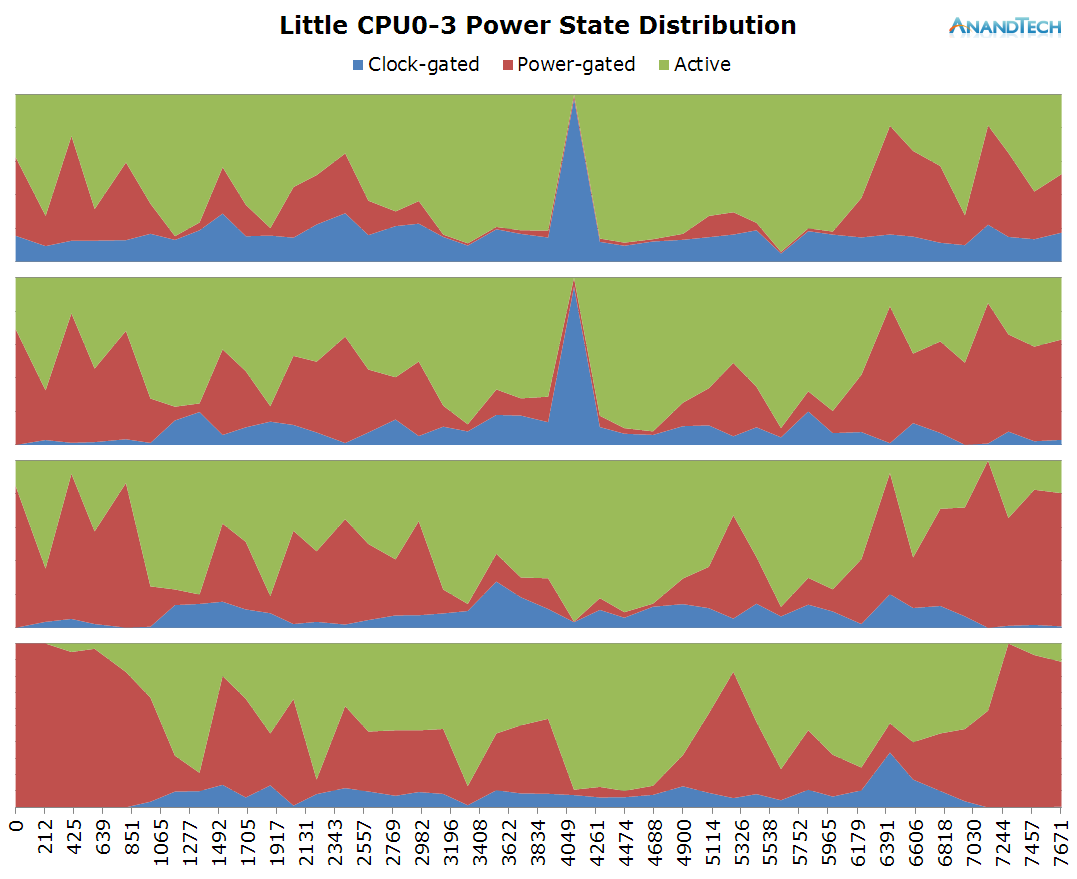
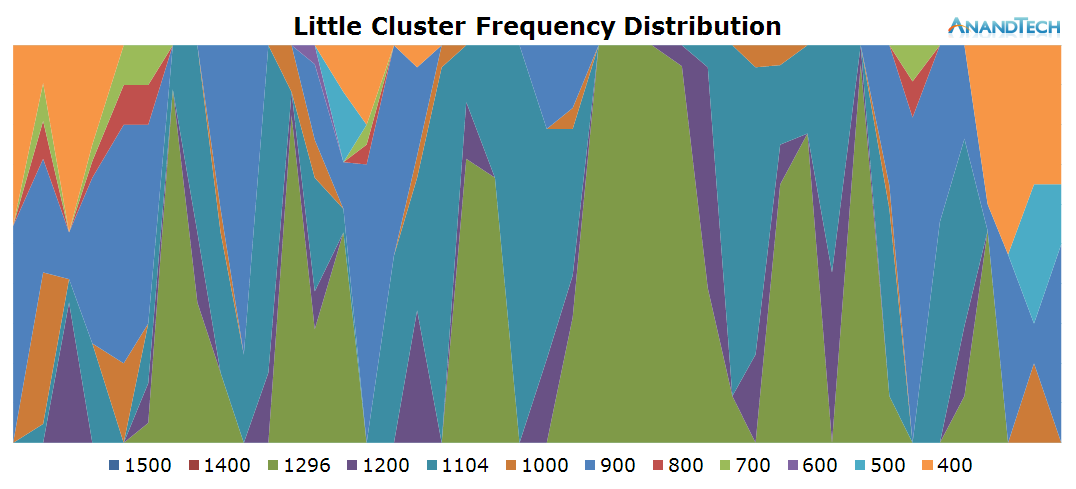
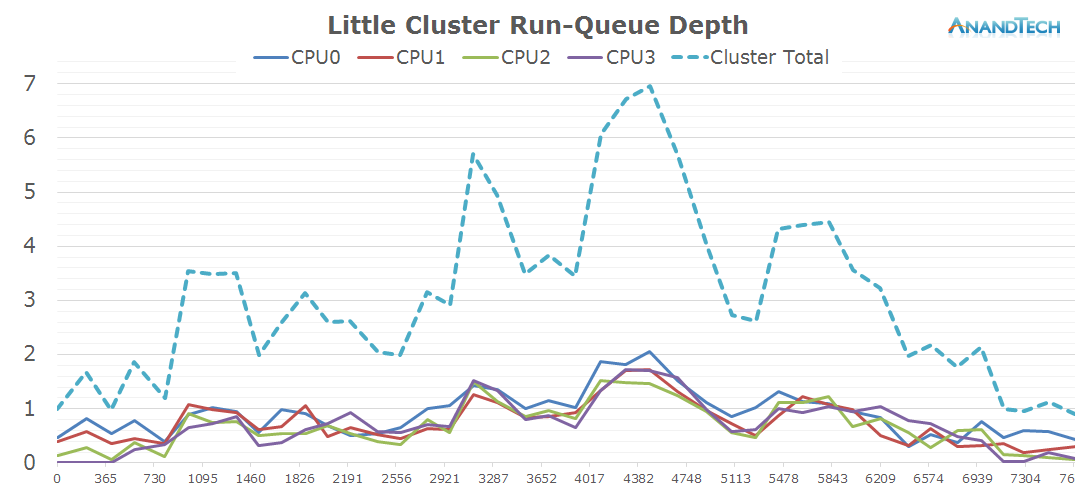
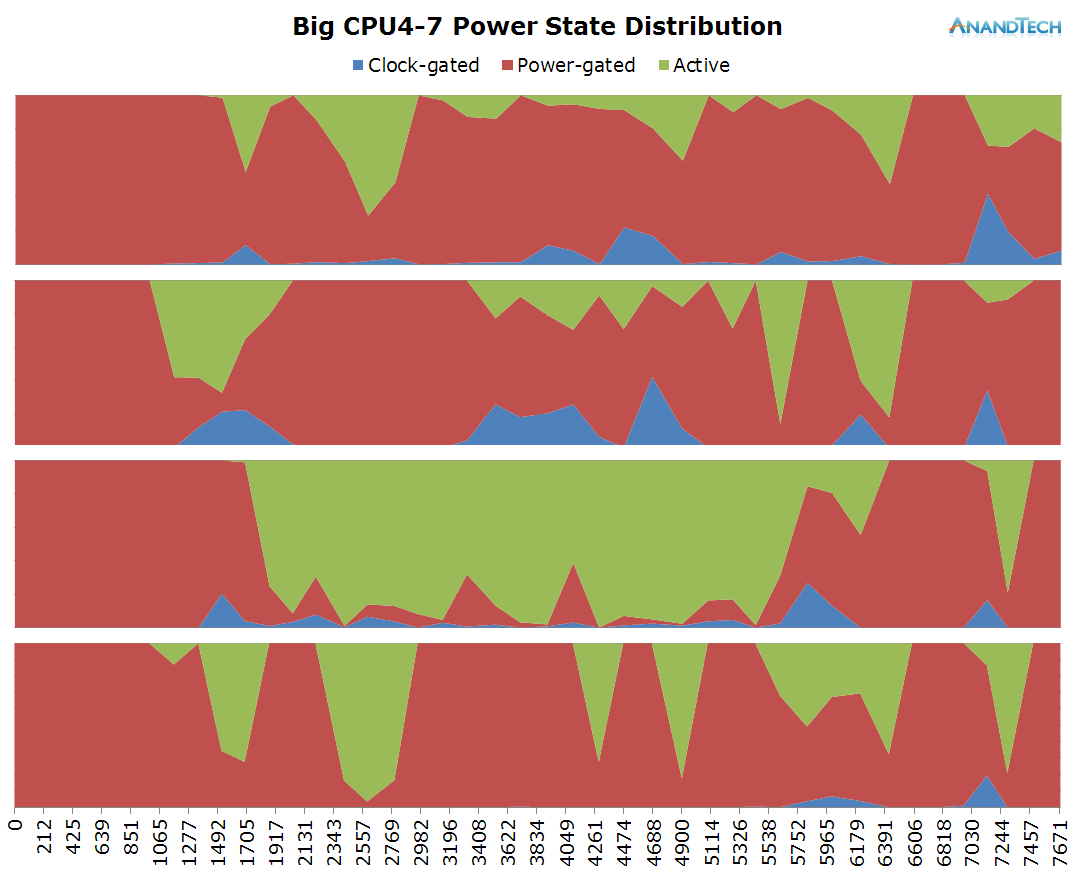
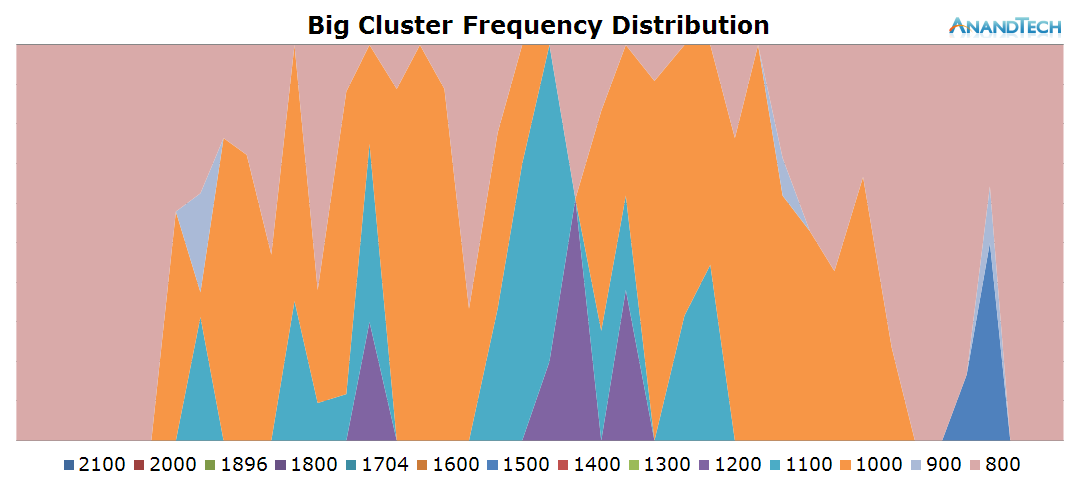
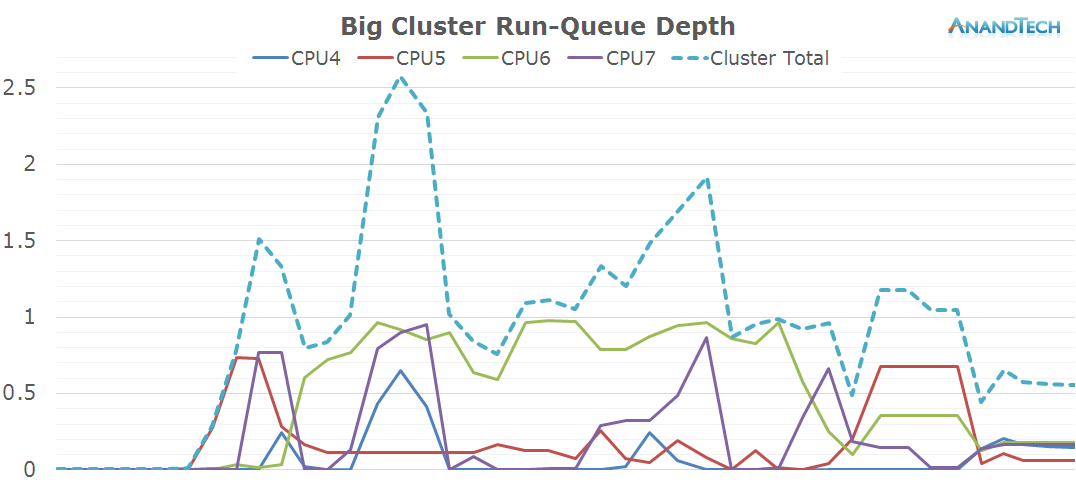
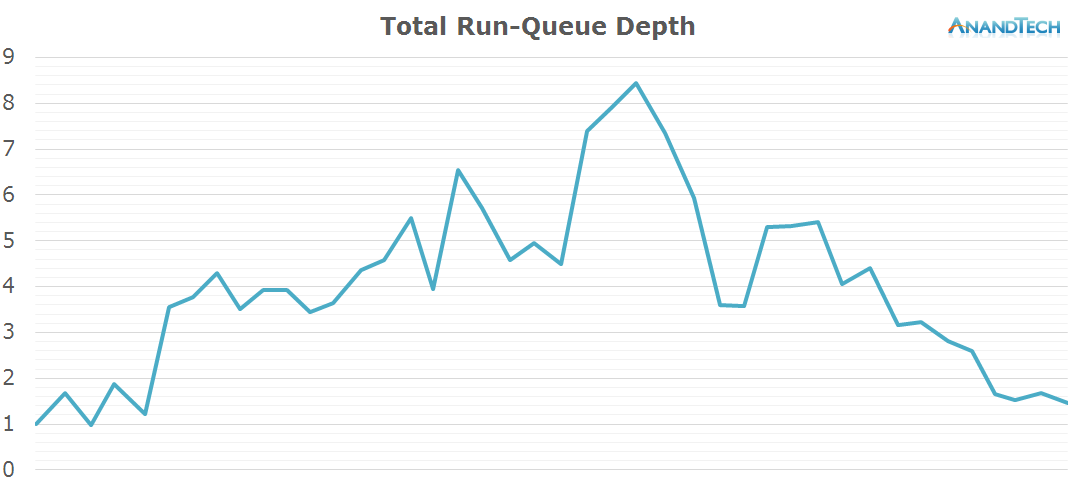








157 Comments
View All Comments
R0H1T - Tuesday, September 1, 2015 - link
Seems like Android has Windows' number as far as "multi-threading" is concerned, kudos to Google for this & seems like the tired old argument of developers getting a free pass (for poor MT implementation on desktops) needs to change asap!Impulses - Tuesday, September 1, 2015 - link
Ehh, I think you're ignoring some key differences in clock speed and single threaded performance, not to mention how easily Intel can ramp clock speed up and back down, and then there's Hyper Threading which allows you to span more threads per core.Laptops might be the outlier, but I dunno what benefit a desktop (which have commonly run quads for years) would see from a lower powered core cluster. Development just works very differently by nature of the environment.
Also things that benefit a ton from parallelization on the desktop often end up using the GPU instead... And/or specialized instructions that aren't available at all on mobile. It's not even apples and oranges IMO, it's apples and watermelons.
R0H1T - Tuesday, September 1, 2015 - link
You're missing the point, which is that Google & Android have shown (even with the vast number of SoC's it runs on) that MT & load management, when implemented properly, on the supported hardware & complementing software, makes great use of x number of cores even in a highly constrained environment like a smartphone.On desktops we ought to have had affordable octa cores available for the masses by now, but since Intel has no real competition & they price their products through the roof, we're seeing what or how windows & the x86 platform has stagnated. Granted that more people are moving to small, portable computing devices but there's no reason why the OS & the platform as a whole has to slow down, also the clock speed, IPC argument is getting old now. If anything DX12, Mantle, Vulkan et al have shown us is that if there's good hardware & the willingness to push it to its limits developers, with the right tools at hand, will make use of it. Not to mention giving them a free pass for badly coded programs, remember the "ST performance is king" argument, is the wrong way to go as it not only wastes the (great) potential of desktops but it also slows down the progress of PC as a platform.
Now I know MT isn't a cakewalk especially on modern systems but if anything it should be more widespread because desktops & notebooks give a lot of thermal headroom, as compared to tablets & smartphones, besides the 30+ years of history behind this particular industry should make the task easier. Also not all compute tasks can be offloaded to GPU, that's why it's even more imperative that the users push developers to make use of more cores & not get the free ride that GPGPU has been giving them over the last few years, as it is the GPU industry is also slowing down massively & then we'll eventually be back to square one & zero growth.
metafor - Tuesday, September 1, 2015 - link
Yes and no. Google and Android are able to show that things like app updates, web page loads and general system upkeep is able to take advantage of multiple threads. But that's been true for a while. In a smartphone, those happen to be the performance dominating tasks. On a desktop, those tasks are noise.Desktop workloads that actually stress the CPU (and users care about performing well) are very different. That's not to say they're not threadable, but they may not be as threadable as Chrome, which basically eats RAM and processes.
That being said, heterogenous MT could make a lot of sense for laptop processors as well. Having threadable workloads run on smaller Atoms instead of big Sky Lakes would probably improve efficiency. But it may not be as dramatic depending on the perf/W of Sky Lake at lower frequencies.
niva - Tuesday, September 1, 2015 - link
OK can we talk about this for a bit. I for one found the webpage CPU usage extremely disturbing. I'm running an old phone, Galaxy Nexus, and browsing has become by far the task my phone struggles with the most. Why is that? What is it about modern websites that causes them to be so CPU heavy? Is that acceptable? It does seem that much of the internet is filled with websites running shady scripts in the background and automatically playing video or sound which is annoying at the very least, but detrimental to performance always. Whatever happened to website optimization for minimizing data usage and actually making websites accessible?Secondly, what is the actual throughput of CPUs in desktops compared to the latest state of the line arm APUs? Just because desktop workloads might be different, does that mean that a mobile APU cannot handle it or is that simply due to the usage mode of the device in question? What I'm seeing out of mobile/phone chips is that they are extremely capable, to the point I'm starting to wonder if I'll ever need another desktop rig to replace my old Phenom X2 machine.
metafor - Tuesday, September 1, 2015 - link
I would guess that websites are just more complicated nowadays. Think about a dynamic website like Twitter, which has to have live menus and notifications/updates. That's basically a program more than just a web page. We've slowly migrated what used to be stand-alone programs to load-on-demand web programs. And added many many inefficient layers of script interpreters in between.emn13 - Thursday, September 3, 2015 - link
Somewhat ironically, the more modern a web-page the *less* friendly it is likely to be to multithreading. After all, modern features tend to include heavy javascript usage (which is almost purely single-threaded), and a CPU usage that is bottlenecked by a path through javascript (typically layout not actually the JS itself, but that layout affects JS and hence needs fine-grained interaction).Jaybus - Tuesday, September 1, 2015 - link
It is the more extensive use of client-side processing, in a nutshell, JavaScript and JSON. On older websites, they dynamic stuff was processed server-side and the client simply did page reloads. The modern sites require less bandwidth, but at the expense of increasing CPU usage.Also, modern sites are higher res and more image intensive, or in other words more GPU heavy as well. Some of the Nexus struggle can be attributed to GPU load.
mkozakewich - Wednesday, September 2, 2015 - link
Most of it has to do with using multiple JavaScript libraries. It's not strange to need to download over 50 different files on a website today. Anandtech.com took 123 requests over four seconds to load. Mostly fonts, ads, and Twitter stuff, but it adds up.name99 - Tuesday, September 1, 2015 - link
You are totally misinterpreting these results.The mere existence of a large number of runnable threads does not mean that the cores are being usefully used. Knowing that there are frequently four runnable threads is NOT the same thing as knowing that four cores are useful, because it is quite possible that those threads are low priority, and that sliding them so as run consecutively rather than simultaneously would have no effect on perceived user performance.
There is plenty of evidence to suggest that this interpretation is correct.
Within the AnandTech data, the fact that these threads are usually on the LITTLE cores, and running those at low frequency, suggests they are not high priority threads.
This paper from MS research confirms the hypothesis:
http://research.microsoft.com:8082/en-us/um/people...
Now there is a whole lot of tribalism going on in this thread. I'm not interested in that; I'm interested in the facts. What the MS paper states (confirmed, IMHO) by these AnandTech results, is that there is a reasonable (around 20%) throughput improvement in going from one to two threads, along with a small (around 10%) energy drop, and that going from two to three or four cores buys you only very slight further energy and performance boosts.
In one sense this means there's no harm in having octacores around --- they don't seem to burning energy, and in principle they could deliver extra snappiness (though the lousiness of the scheduling in these AnandTech results suggests that's more a hope than a reality). But there's a world of difference between the claim "doesn't hurt energy, may occasionally be slightly useful" and the claim "pretty much always useful because apps are so deeply threaded these days".